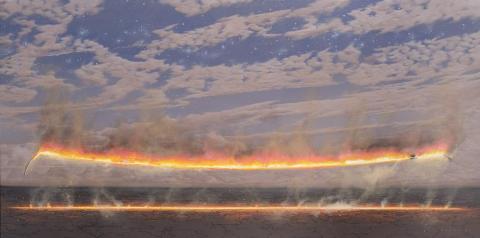STARLIGHT BLAZE LINE, 2007
Tim Storrier
synthetic polymer paint on linen
152.5 x 305.0 cm
signed lower right: Storrier
signed and titled verso on stretcher
Tim Olsen Gallery, Sydney
Private collection, Sydney
When Tim Storrier first strung a piece of rope between two poles and set it alight, he had no idea that he was opening a creative seam that would sustain his work for decades: a seam rich in concepts and images relating to the distance between two points and the rope as a defining and tensioning device between these points.'1
With its sublime beauty and disorienting juxtaposition of real and surreal, Starlight Blaze Line, 2007, encapsulates the highly individual evocations of nature that have brought Tim Storrier such widespread acclaim. Fascinated by the concept of the seemingly endless horizon - and particularly, that exciting point where horizon meets the sky - during the mid-eighties, Storrier began experimenting with three-dimensional constructions of wire, rope and steel which he would install in remote locations and subsequently ignite, capturing the entire dramatic event on cibachrome film. Deriving their impetus primarily from these 'performances', the 'point to point' paintings such as the present thus explore an iconic image whose atmospheric resonance differs widely depending upon the time of day or night.
Concerned with the elements of light, action and stillness, Storrier here merges the real and imagined to construct a highly personal landscape imbued with the 'myth of the outback'; as he muses, 'The idea of those horizons is something I still find challenging and rather wonderful. But again it is my view; it is not the reality of the farmer or the people that live there. It is a mythical quotient that had probably gone. As with Delacroix's Death of Sardanapolous, the painting is a myth.'2 Drawing upon memory and intuition to forge a potent symbol of place, indeed Storrier has been compared to artists such as Streeton and Roberts who fused the actuality of the Australian bush with a sense of poetry, and Nolan and Drysdale who, realising the Australian outback as a vast and uncompromising landscape, pursued theatrical possibilities for creating a distinct and identifiable consciousness.3 In his preoccupation with the effects of light and atmosphere, Storrier's work also bears strong affinities with the European tradition of romantic landscape painting, and specifically, Constable and Turner with their 'great big skies, endless horizons and the air you can cut with a knife - thick with moisture.'4
1. Murray Cree, L., Dust and Ashes, Sherman Galleries, Sydney, 2003.
2. Storrier cited in Hart, D., 'The Australian Context: Real and Imagined', Tim Storrier: Burning of the Gifts, Australian Galleries, Sydney, 1989, p. 19
3. Hart, ibid., p. 18.
4. Hart, ibid., p. 19.
VERONICA ANGELATOS
